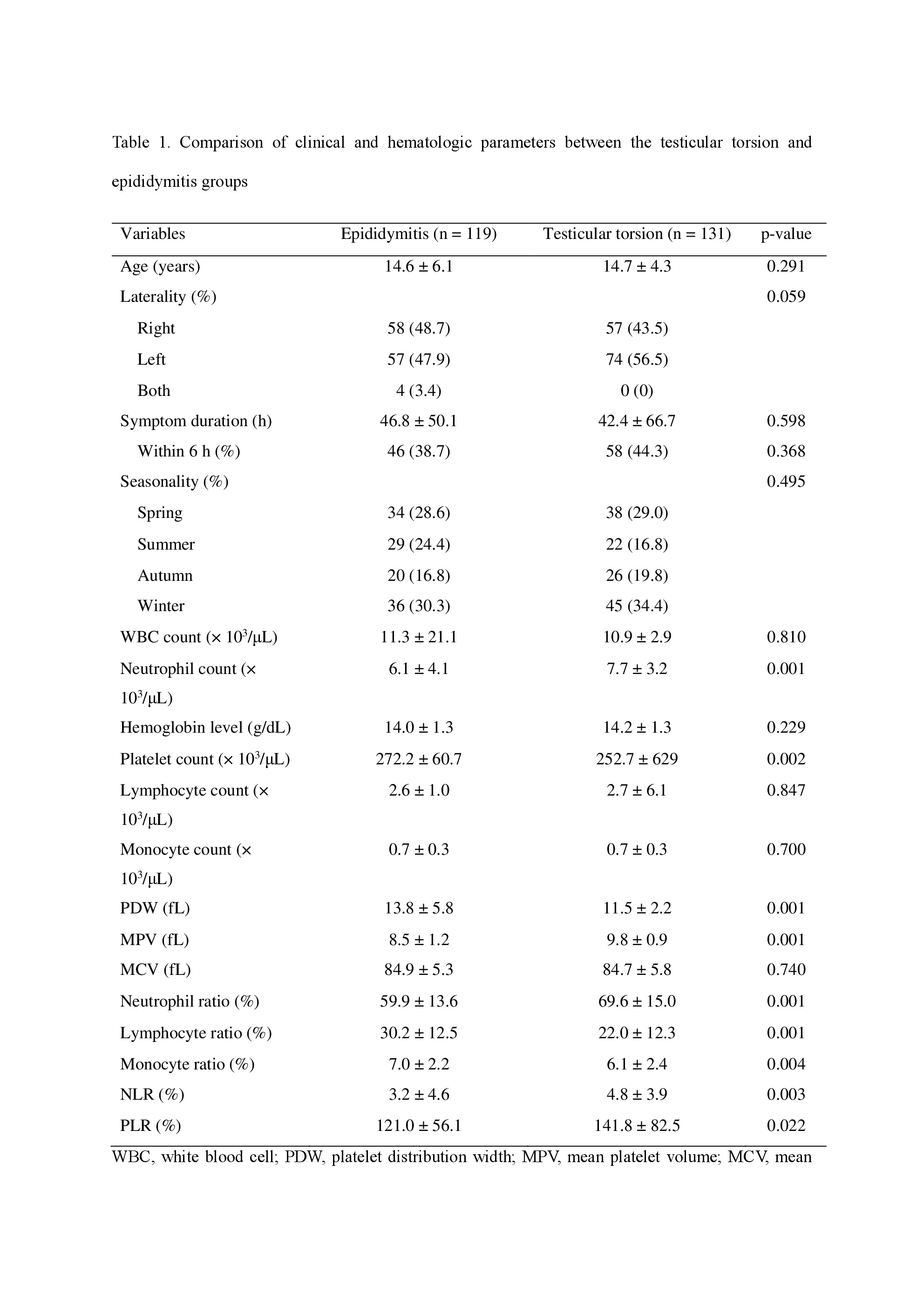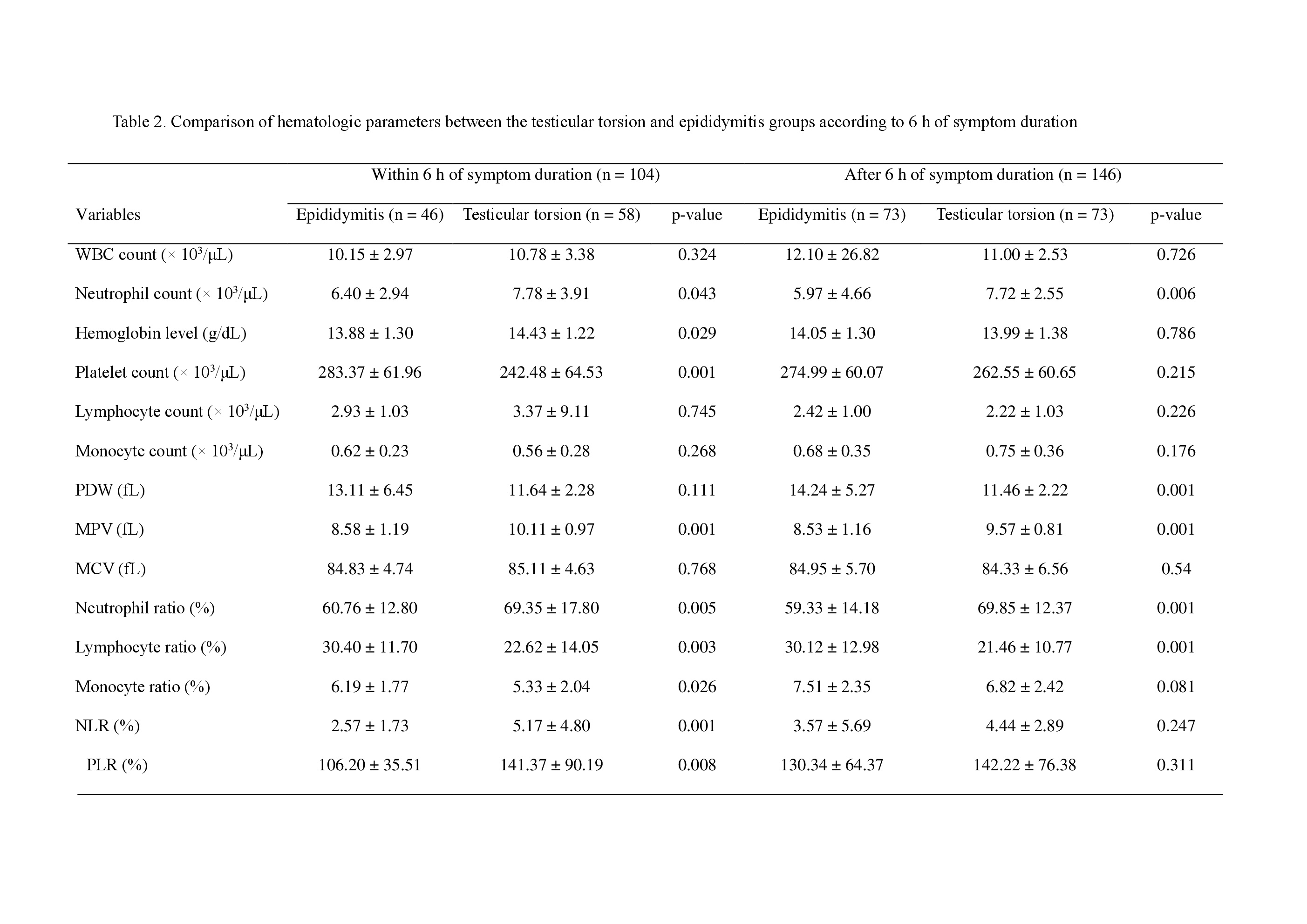Back
Poster, Podium & Video Sessions
Moderated Poster
MP37: Infections/Inflammation/Cystic Disease of the Genitourinary Tract: Prostate & Genitalia
MP37-13: Mean platelet volume is the most valuable hematologic parameter in differentiating testicular torsion from epididymitis within the golden time
Sunday, May 15, 2022
7:00 AM – 8:15 AM
Location: Room 225
Chung Ho Seok*, Yu Seong Hyeon, Hwang Eu Chang, Kim Sun-Ouck, Oh Kyung Jin, Jung Seung Il, Kang Taek Won, Kwon Dongdeuk, Park Kwangsung, Gwangju, Korea, Republic of
- HC
Ho Seok Chung, MD,PhD
Chonnam National University Hwasun Hospital
Poster Presenter(s)
Introduction: We aimed to assess the diagnostic value of hematologic parameters in the differential diagnosis of testicular torsion and epididymitis within and after the golden time.
Methods: We retrospectively reviewed the records of 250 patients aged < 25 years who were diagnosed with epididymitis (n = 119) or testicular torsion (n = 131). The characteristics and hematologic parameters of patients in the two groups were analyzed. Receiver operating characteristic curves were used to assess the validity of hematologic parameters as differential diagnostic tools with respect to the golden time (defined as 6 h of symptom duration). Further, we evaluated the predictive factors associated with orchiectomy in patients with testicular torsion.
Results: The mean patient age was 14.4 years. Among patients with testicular torsion, 91.40% underwent detorsion and orchiopexy within the golden time, whereas only 27.40% of the affected testes were preserved after the golden time. Regardless of symptom duration, white blood cell count, neutrophil count, neutrophil ratio, mean platelet volume (MPV), and neutrophil-to-lymphocyte ratio could differentiate testicular torsion from epididymitis. Within the golden time, MPV seemed to be the most valuable diagnostic parameter (area under the curve 0.855, 95% confidence interval: 0.778–0.932). In a multivariate analysis, symptom duration (symptoms beyond the golden time) was associated with orchiectomy in patients with testicular torsion.
Conclusions: MPV showed the greatest diagnostic value in the early stage of testicular torsion and epididymitis, suggesting its potential use for the differential diagnosis of these two conditions within the golden time.
Source of Funding: None



Methods: We retrospectively reviewed the records of 250 patients aged < 25 years who were diagnosed with epididymitis (n = 119) or testicular torsion (n = 131). The characteristics and hematologic parameters of patients in the two groups were analyzed. Receiver operating characteristic curves were used to assess the validity of hematologic parameters as differential diagnostic tools with respect to the golden time (defined as 6 h of symptom duration). Further, we evaluated the predictive factors associated with orchiectomy in patients with testicular torsion.
Results: The mean patient age was 14.4 years. Among patients with testicular torsion, 91.40% underwent detorsion and orchiopexy within the golden time, whereas only 27.40% of the affected testes were preserved after the golden time. Regardless of symptom duration, white blood cell count, neutrophil count, neutrophil ratio, mean platelet volume (MPV), and neutrophil-to-lymphocyte ratio could differentiate testicular torsion from epididymitis. Within the golden time, MPV seemed to be the most valuable diagnostic parameter (area under the curve 0.855, 95% confidence interval: 0.778–0.932). In a multivariate analysis, symptom duration (symptoms beyond the golden time) was associated with orchiectomy in patients with testicular torsion.
Conclusions: MPV showed the greatest diagnostic value in the early stage of testicular torsion and epididymitis, suggesting its potential use for the differential diagnosis of these two conditions within the golden time.
Source of Funding: None




.jpg)
.jpg)